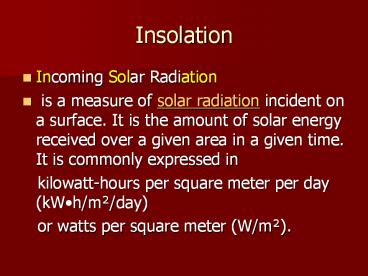Insolation - PowerPoint PPT Presentation
1 / 19
Title:
Insolation
Description:
Insolation Incoming Solar Radiation is a measure of solar radiation incident on a surface. It is the amount of solar energy received over a given area in a given time. – PowerPoint PPT presentation
Number of Views:520
Avg rating:3.0/5.0
Title: Insolation
1
Insolation
- Incoming Solar Radiation
- is a measure of solar radiation incident on a
surface. It is the amount of solar energy
received over a given area in a given time. It is
commonly expressed in - kilowatt-hours per square meter per day
(kWh/m²/day) - or watts per square meter (W/m²).
2
Surface Energy Budget Remotely Sensed Components
Satellite images
SWup LWup
Convection
SWdown
LWup
SWup
LWdown
latent heat
3
Electromagnetic Energy from the Sun
4
Electromagnetic Spectrum
The Sun emits light energy throughout the entire
spectrum
5
The Multi-Wavelength Sun
UV
Visible
X-Ray
Composite
Radio
Infrared
6
The Electromagnetic Spectrum
Describe most of the electromagnetic spectrum.
Most of the Electromagnetic spectrum is
invisible!!!
7
Fluorescent lights
- Fluorescent lights stimulate emission among atoms
like argon, mercury, neon - they do this by ionizing the gas with high
voltage - Mercury puts out a strong line at 254 nm (UV)
- this and other lines hit the phosphor coating on
the inside of the tube and stimulate emission in
the visible part of the spectrum
8
Orbital Variations and InsolationObliquity or
Tilt
- Tilt angle presently 23.5
- Variations in tilt angle change seasonality,
especially in high latitudes
9
Light absorption
white light
blue light
red light
green light
B G absorbed
R G absorbed
B R absorbed
10
Selective absorption
- Carotene
- makes carrots orange, tomatoes red, daffodils
yellow, leaves turn - must absorb blue light
- Chlorophyll
- makes leaves green
- must absorb red and blue
11
Earths Average distance the sun
December 147.7 million km November 147.7
million km October 150.3 million km September
150.3 million km August 152.3 million km July
153.0 million km June 153.0 million km May
151.7 million km April 150.3 million km March
149.0 million km February 147.7 million
km January 147.1 million km
What is More important The Distance from the
Sun? or Angle of the Sun?
Since we are closer in the winter by almost 6
million km, the angle is more important.
12
Earths Solar (Shortwave) Radiation Balance
100 sunlight in at top of atmosphere
19 45 25 6 5 100
Why does this condition create a surplus?
70 is gained and 30 is lost to space.
13
Daily/Seasonal Radiation Patterns
When is the most Energy received from the sun?
Noon
When is the warmest Time of the day?
4 pm
Although noon is the greatest amount of energy,
Why does the warmest time of the day occurs after
maximum insolation?
There is still a surplus of energy prior to
sunset.
14
Solar panels directed at the sun.
15
Power Towers
Thousands of sun-tracking mirrors (heliostats)
focus sunlight on a central tower
- Energizes a heat-transfer fluid.
- Californias Solar Two heats molten salt to 565C
(1050 F). - Heat exchangers create high-pressure steam.
- Hot salt can be stored for dispatchable power.
NREL
16
Insolation kwh/sq m/day
- June 21
Dec 21 - Kansas City, MI 6.1 3.0
- Boston, MA 5.0 2.2
- Denver, CO 6.7 4.4
- Eugene, OR 6.1 1.7
- Miami, FL 5.0 3.9
- San Diego, CA 7.1 4.3
- Tucson, AZ 7.1 5.0
17
Greenhouse Effect
- Relates to the trapping of insolation
- by gases in the atmosphere
- Major Green House Gases
- CO2 Carbon Dioxide
- H20(v) Water Vapor
- CH4 Methane (natural gas)
- The Atmosphere/Greenhouses are
- transparent to insolation (incoming)
- opaque to longwave (outgoing)
- Greenhouses reduce the loss of energy
- by limiting convection
How could you decrease the Greenhouse effect?
Decrease the amount of greenhouse gases.
18
Theory of the Ice Ages
Describe how the climate changes every 100,000
years.
Either a Ice age or Warm climate.
19
Summary
- Incoming solar radiation or insolation changes
with the seasons. - Maximum insolation occurs at noon.
- Maximum Temperature occurs after solar noon.
- The greenhouse effect limits the loss of energy.
- Capturing sunlight can reduce production of
greenhouse gases.































